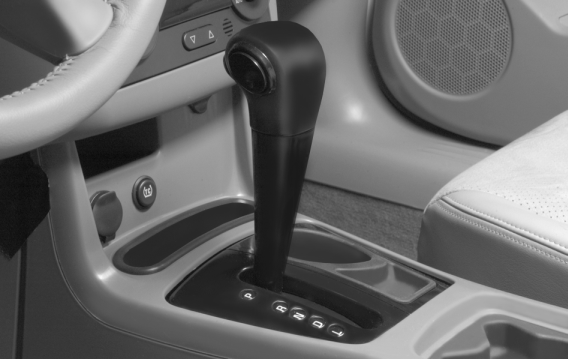
Your automatic transaxle has a shift lever located on the console between the seats.
PARK (P): This position locks your front wheels. It's the best position to use when you start your engine because your vehicle can't move easily.Caution: It is dangerous to get out of the vehicle if the shift lever is not fully in P (Park) with the parking brake firmly set. The vehicle can roll.
Do not leave the vehicle when the engine is running unless you have to. If you have left the engine running, the vehicle can move suddenly. You or others could be injured. To be sure the vehicle will not move, even when you are on fairly level ground, always set the parking brake and move the shift lever to P (Park). See Shifting Into Park . If you are pulling a trailer, see Towing a Trailer .Ensure the shift lever is fully in PARK (P) before starting the engine. Your vehicle has an automatic transaxle shift lock control system. You have to apply your regular brake before you can shift from PARK (P). If you cannot shift out of PARK (P), ease pressure on the shift lever, then push the shift lever all the way into PARK (P) as you maintain brake application. Then move the shift lever into the gear you wish. (Press the shift lever button before moving the shift lever.) See Shifting Out of Park later in this section.
REVERSE (R): Use this gear to back up.Notice: Shifting to REVERSE (R) while your vehicle is moving forward could damage the transaxle. The repairs would not be covered by your warranty. Shift to REVERSE (R) only after your vehicle is stopped.
To rock your vehicle back and forth to get out of snow, ice or sand without damaging your transaxle, see If Your Vehicle is Stuck in Sand, Mud, Ice, or Snow .
NEUTRAL (N): In this position, your engine doesn't connect with the wheels. To restart when you're already moving, use NEUTRAL (N) only. Also, use NEUTRAL (N) when your vehicle is being towed.Caution: Shifting into a drive gear while the engine is running at high speed is dangerous. Unless your foot is firmly on the brake pedal, the vehicle could move very rapidly. You could lose control and hit people or objects. Do not shift into a drive gear while the engine is running at high speed.
Notice: Shifting out of PARK (P) or NEUTRAL (N) while the engine is running at high speed may damage the transaxle. The repairs would not be covered by your warranty. Be sure the engine is not running at high speeds when shifting your vehicle.
DRIVE (D): This position is for normal driving. If you need more power for passing, and you're:| • | Going less than 35 mph (56 km/h), push your accelerator pedal about halfway down. |
| • | Going about 35 mph (56 km/h) or more, push the accelerator all the way down. |
You'll shift down to the next gear and have more power.
Notice: If your vehicle seems to start up rather slowly or not shift gears when you go faster, and you continue to drive your vehicle that way, you could damage the transaxle. Have your vehicle serviced right away. You can drive in LOW (L2) when you are driving less than 35 mph (56 km/h) and DRIVE (D) for higher speeds until then.
LOW (L): This position gives you access to THIRD, SECOND and FIRST gears for more power but lower fuel economy than AUTOMATIC OVERDRIVE (D). You can use it on very steep hills, or in deep snow or mud. If the electronic range select is put in LOW (L1), the transaxle won't shift into lower gears until the vehicle is going slow enough.Electronic Range Select Mode
This feature allows you to select lower driving gears. The button for this mode is located on the left side of the shift lever knob.
The electronic range select mode only changes gear when the shift lever is in LOW (L).
When the shift lever is first moved into the LOW (L) position, the display in the instrument panel shows L3. Press the (-) end of the button on the shift lever once for L2 and once more for L1. Press the (+) end of the button to return to L2 and L3. The shift lever must be moved back to DRIVE (D) to turn off the electronic range select mode.
